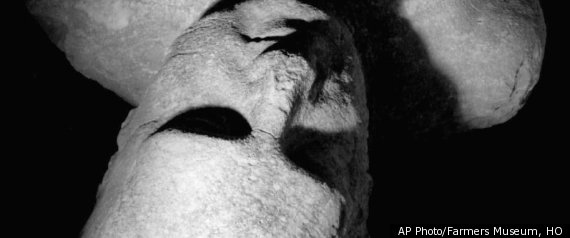In 1869, the petrified remains of a 10-foot-4-inch giant, pulled from the ground in upstate New York, became a national sensation.
Newspapers across the country ran features of the amazing discovery. Believers traveled great distances and stood on long lines to feast their eyes on this wonder. Some speculated that the discovery somehow related to biblical references to giants who once roamed the world.
It was, of course, a load of crap. A tobacco salesman and avowed atheist named George Hull cooked up this hoax, after getting into a fight with a minister, to prove just how gullible the public is.
Hull commissioned a sculpture, buried it on his cousin's property, and helped perpetuate the hoax when the petrified man was supposedly dug up.
It was soon dubbed "Cardiff Giant," and it became so famous that legendary showman P.T. Barnum soon found his own bogus giant, which he attempted to pass off as the real thing.
Syracuse-based artist Ty Marshal wants to pay homage to one of the greatest hoaxes of all time by reduplicating the actual events.
Marshal insists that his attempt to build an exact replica of the Cardiff Giant, made from gypsum, is no joke.
Instead, it's a labor of love to celebrate what is considered a watershed moment in modern media, he said.
"I'm doing an artistic endeavor about the hoax," Marshal said. "We're recreating the giant, burying it in the ground and digging it up on Oct. 16, the 142nd anniversary of the 'discovery.' Of course, we have to put the word 'discovery' in quotes."
The story of the Cardiff Giant starts with Hull, who, in 1868, hired Edward Burghardt, a German stonecutter, to create a giant model out of gypsum.
He told Burghardt it was supposed to represent Abraham Lincoln, but after Hull got possession of it, he laid a board full of nails on it to simulate pores, gave it an acid bath to make it look like it had aged and buried it on William Newell's farm.
Then, on Oct. 16, 1869, Newell hired two men to dig for a well at the exact spot where the so-called "Cardiff Giant" was buried.
When Barnum figured out how much money was being made from people paying for a peek, he tried to buy the Giant and, when refused, created his own, which he claimed was the real one.
"It really is a giant moment in media," Marshal said. "It attracted so much attention so quickly. The news traveled across the nation and you had all these characters all trying to make a buck."

The whole thing came to a head in court in February 1870, when a group of businessmen who purchased the Cardiff Giant from Hull for $37,500 sued Barnum for claiming their giant was fake and that he had the real one.
Ironically, Barnum's replica Giant was drawing better than the real fake statue, according to hoax historian Alex Boese, who runs the Museum Of Hoaxes website.
Boese said the judge refused to hear the case unless the "genuineness" of the original could be proven and the owners sheepishly dropped their charges.
But that wasn't the end of the Cardiff Giant gravy train.
"The brilliant thing that happened afterwards is that guy who owned it made money by letting people see how they were duped," Marshal said. "Kind of like when people go to see a movie again so they can piece it together."
Marshal believes this prototypical media prank started a river of weirdness that created tributaries that led, on one hand, to shows like "Punk'd" and conceptual artists like The Yes Men and Joey Skaggs, who use pranks as a form of social protest, and on the other, to journalistic stories focusing on the weird, such as Ripley's Believe It Or Not! and HuffPost Weird News.
However, Boese sees the hoax as more of a line between two eras.
"It definitely brought the idea of hoaxes to the fore," he said. "At first, people were searching for this romantic pre-history of America. But after the hoax was revealed, it became this symbol of charming innocence, of a more naive time."
These days, the original Cardiff Giant is housed at the Farmer's Museum in Cooperstown, N.Y., (one of the sponsors to Marshal's project), and Barnum's replica can be found in Detroit at Marvin's Marvelous Mechanical Museum, although Boese takes the provenance of that one with a grain of salt.
"There were at least four Cardiff Giants," Boese said. "The owner doesn't have real provenance that his was the one owned by Barnum."
